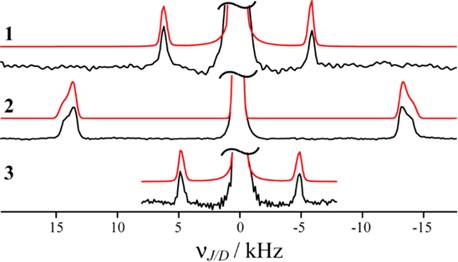Reports: ND653752-ND6: Solid-State NMR Studies of Heterometallic and Homometallic Organic Frameworks
David L. Bryce, PhD, University of Ottawa
Significant progress has been made in our ACS PRF New Directions project in the first year of funding. In particular, several developmental advances have been made which lay the required groundwork for applications in year 2. In addition, several students and post-doctoral fellows have worked on this project, resulting thus far in five publications.
Our project aims to develop and apply advanced multinuclear magnetic resonance (NMR) methods to study and characterize metal-organic frameworks (MOFs) and related functional materials. Within this theme, there are several related directions we are pursuing. First, we have refined our NMR crystallographic methods to provide high-resolution structural information on MOFs. We have harnessed the information available from quadrupolar metal isotopes such as 91Zr, 95Mo, and 25Mg to solve and publish the structure of a zero-thermal expansion material, ZrMgMo3O12. Such isotopes, with spin quantum numbers of greater than ½, present technical challenges related to the acquisition and interpretation of their NMR spectra. However, our work has demonstrated the validity of our approach and has indeed provided structural information unavailable from other methods. The next breakthrough has been to develop and apply novel solid-state NMR methodology to characterize pairs of quadrupolar nuclei such as those involved in metal-metal bonds, or more generally in heterometallic or homometallic MOFs. We have demonstrated the validity of our methods through published works on boron-boron spin pairs and gallium-gallium spin pairs in model systems (see Figure 1). This work provides direct and quantitative information into the metal-metal bond via indirect nuclear spin-spin coupling constants.
Figure 1. Shifted-echo J/D-resolved NMR pulse sequence (a) and the resulting theoretical spectra for the AX (b) and A2 (c) cases (quadrupolar spin pairs in stationary powdered samples). Note the inversion of the sense of the line shapes in the AX compared with the A2 case. Insets in panel b are enlarged. From Perras and Bryce, J. Phys. Chem. Lett., 2014, 5, pp 4049–4054.
Shown in Figure 2 are J/D-resolved 71Ga NMR spectra with splittings indicative of spin-spin coupling across the metal-metal bond. These results have been paired with density functional theory computations to understand the nature of the metal-metal bond. In addition, the size of the splitting as well as the sense of the powder patterns which make up each component of the doublets in Figure 2 provides a novel and direct insight into the crystallographic symmetry. This work was carried out in the very high magnetic field of 21.1 T (900 MHz proton resonance frequency), which was essential for sensitivity reasons. We have published related work which provides unique insight into the nature of the boron-boron triple bond in borynes, demonstrating via J couplings that such compounds are spectroscopically analogous to alkynes.
Figure 2. J/D-resolved 71Ga NMR spectra (stationary powdered samples; B0 = 21.1 T) of three compounds featuring gallium-gallium bonds. Red: simulated; black: expt. The peak at zero frequency is truncated for clarity. From Perras and Bryce, J. Phys. Chem. Lett., 2014, 5, pp 4049–4054.
In year 2, the focus will also be squarely placed on dimetallic MOFs incorporating paramagnetic dopants. The influence of the paramagnetic metals on the spectral signatures of the surrounding nuclei is expected to provide novel insights into the local structure and gas binding sites. A dedicated post-doctoral fellow has been recruited to synthesize heterometallic and homometallic MOFs and this work is well underway. In addition to providing structural information on this class of MOFs and the nature of the metal-metal bond, we aim to detect the influence of adsorbed gases on the NMR spectrum of the metal nuclei in the MOFs, thereby providing a unique and sensitive handle on the location and nature of gas binding sites in such systems.
The impact of the work to date on the career of the PI and of the students involved has been substantial. For example, F. Perras has earned his Ph.D. and moved onto a prestigious postdoctoral fellowship at Ames Laboratory. S. Nour has earned a M.Sc. degree and taken up a job in industry. My lab has received substantial funding over the past year including a $445k Discovery Grant from the Natural Sciences and Engineering Research Council (NSERC) of Canada, as well as a $120k Discovery Accelerator Supplement. These grants will be leveraged to further advance the work described here.













